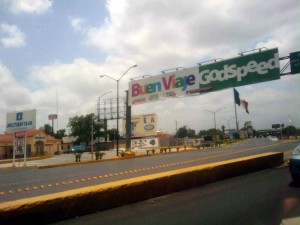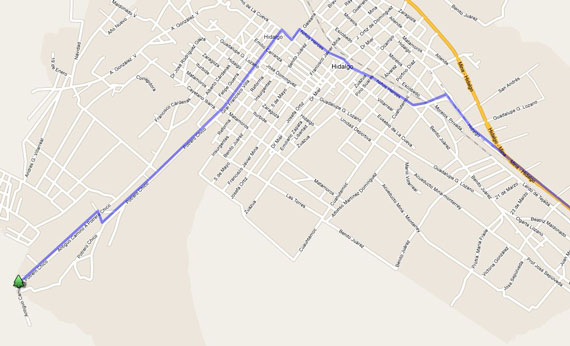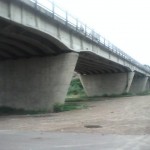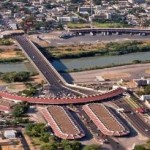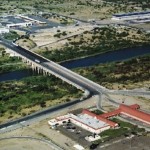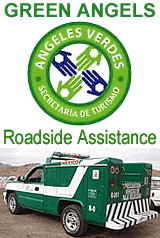Driving to Potrero Chico
- Map Overviews
- Step by Step Driving Directions
- Vehicle Import Permit
- Vehicle Title
- Mexican Car Insurance
- Suggested Insurance Companies
- Fees At Laredo Crossing
- Laredo, Texas Passenger Bridges
- Toll Road To Monterrey
- Mexican Driving Styles
- Dealing With The Police
- Inspection Station Red Light
- Gas Stations
- Returning to the United States
- Other Notes and Advice
From the U.S. border at Laredo, Texas
Driving to Potrero Chico from the United States border is a cheap and fun way to get the full Mexican experience – airplanes, buses and taxis limit what you see on your trip. Its particularly advantageous if you are traveling in a group with a lot of gear. Driving is a popular alternative for Americans and Canadians and is routine for many life-long, repeat Potrero Chico climbers. A down side is the border towns of Mexico and the United States, such as Laredo, are known for being dangerous – a common discouraging factor for many would-be drivers. While the hype over most of these border towns are somewhat valid, non-stop drive thrus of these towns during day light hours make these crossings much safer. There are many climbers who annually make these border crossings – safely and worry-free. Knowing Spanish, though it helps, is not mandatory. For more information on safety issues, see the page Safety In Mexico.
The following is a comprehensive guide to driving to Potrero Chico that is loosely based on previous driving guides, in-depth research and many 1st-hand border crossings by U.S. citizens. The guide assumes you will be crossing into Mexico from Laredo Texas – it is the closest American city to Potrero Chico. In the Laredo there are actually 3 different bridges to choose from, each with their own advantages. Our overall recommendation is that you cross into Mexico on Laredo International Bridge II because it is the most direct from I-35. However, when returning to the United States, depending on the time of day, it might be more advisable that you cross at the Columbia Bridge because of shorter lines, despite it being more out of the way. See the section Laredo, Texas Passenger Bridges.
The following are the step-by-step driving instructions for crossing at Laredo International Bridge II. We suggest you take the time to read all of the information in this guide and print a copy for your car.
Map Overviews
Laredo Bridge II Border Crossing

Crossing the bridge and making the u-turn

View In Google Maps:
Step by Step Driving Directions
These instructions assume you are crossing at the Laredo International Bridge II.
Vehicle Import Permit
Before driving into Mexico with your car for the first time you will need to prepare the proper documentation to temporarily import your vehicle. At the border you will be required to purchase a “Vehicle Import Permit”. This permit includes both a paper certificate and a silver hologram sticker that has to be placed on your windshield of your car in the top center – near your rear view mirror. The permit is valid for 6 months and allows unlimited exit and re-entry into Mexico with your car during this time.
It is important that you don’t lose the two vehicle permit documents because you must cancel your permit the final time you leave Mexico before the 6 months are over. If you do not cancel your permit, you will not be able to get another permit in the future and your credit card may be charged extra fees/taxes. For those who stay longer than 6 months, you must leave the country with your vehicle for 24 hours before you can reenter and apply for a new vehicle import permit.
Getting the permit can be a little complicated and time consuming – especially if you are not adequately prepared. This is what you’ll need:
- Valid Passport
- Drivers License
- Vehicle Title In Your Name
- Bank-Issued Credit or Debit Card In Vehicle Owners Name
- Return Receipts for Previously Issued Import Permits
- Mexico Car Insurance (optional)
Vehicle Title
It is very important to have the title to your vehicle and that it be in your exact name. The officials at the Mexican customs office are usually very strict about ensuring the name of the cars title matches exactly to your passport. People have been turned away by simply having a suffix of their name be wrong, such as “Jr”. If your car title has a lien holder or co-owner its important you have a notarized letter stating you have permission to leave the country with your car. If you have not finished payments on your car you must get a get a note from your bank stating permission to cross. While these rules are not always enforced 100%, its better to be prepared than to have long delays at the border.
Official vehicle title conditions and requirements (courtesy of Google Translate):
- Title to vehicle registration, credit agreement or a valid invoice letter no longer than three months from the date it was issued by the company or institution that is funding the purchase.
- Lease, in the case of leased vehicles, which must be valid, in the name of the person concerned and a letter from the lessor to authorize the temporary vehicle import.
- If the title is in the name of her husband (a), son (s) or parent must present a birth certificate or marriage as applicable.
Official permit information from Mexican Government (Spanish) here.
Mexican Car Insurance
Mexican car insurance is not mandatory but is highly advisable because in the event that you have an accident you must show “financial responsibility.” If you do not have Mexican insurance to prove this you might have to go to jail until all the deputes and costs are resolved. The cost of your insurance will depend on many factors including the value of your car, the extent of your stay, amount of coverage, and the states of Mexico it is valid in. You can sometimes get cheaper car insurance by buying an entire 6 months than buying just several weeks, and you can also save by only getting insurance valid in the Mexican states that border the U.S. We encourage you to shop around and try different insurance features.
Suggested Insurance Companies
- Sanborn’s Mexico Insurance
- Mexico Insurance Services
- Bravo Insurance Agency
- Baja Bound
- International Insurance Group
- BextMex
Fees At Laredo Crossing
| Approximate Fees | Pesos | USD |
|---|---|---|
| 6 Month Tourist Visa | $268 | $22.53 |
| Vehicle Import Permit | $422 | $35.52 |
| Photocopies Of Your Documents | $24 | $2 |
| 6 Months Mexican Car Insurance ($5000 valued car, valid on border states 9/1/2010) |
$2,116 | $176 |
| Toll Road To Monterrey – 2 Axle Car (They only accept pesos) | $186 | $15.63 |
| Laredo International Bridge Crossing Toll | $3 – Cars $4 – 2 Axle Trucks |
*These fees are based on past experience but may be out of date or not applicable to your situation.
Laredo, Texas Passenger Bridges
Laredo International Bridge II and Colombia Bridge are the two crossing you will want to consider for driving into Mexico. Laredo is more direct and is connected directly to US I-35 while Colombia is perhaps safer because it is not within a city, is newer, and is usually empty. You must cancel your vehicle permit at the same station you received it.
| Bridge Name | Hours | Lanes | Notes |
|---|---|---|---|
| Laredo Bridge I – “Gateway to the Americas” | 24 hrs/day | 4 | Requires you to drive through downtown Laredo. Better for crossing on foot. |
| Laredo Bridge II – “Juárez–Lincoln” | 24 hrs/day | 12 | More direct and probably faster during non-peak hours |
| Colombia Solidarity Bridge | 8am-Midnight | 4 | Usually the fastest lines, but requires more driving to get there |
Toll Road To Monterrey
In the past it has been a choice whether to spend the extra $20 USD to drive the faster/better grade/safer toll road to Monterrey from Laredo. Now, with Mexico’s current crime problems, it really is not a decision. The smaller highways and backroads, although free, are well known to be very dangerous. It is common for the drug cartels to setup fake checkpoints – mainly to stop rival drug cartels but also for petty theft. The Monterrey-Laredo toll road, however, is guarded by the Mexican military and police.
Additionally, there are some other perks to driving the toll road. If you by chance have car problems, you will be quickly rescued by a group of mobile mechanics called the Green Angels, or Ángeles Verdes. They constantly patrol the road in green trucks and offer free assistance in the case of a breakdown (free labor and towing, replacement parts at expense of car owner). They can also help with tourist information. Services are free but tips are appreciated.
Toll Road Insurance
Lastly, driving the toll road automatically gives you toll road insurance. The back of your reciept from the toll booth should describe the insurance. There are two different coverage situations – if you are at fault or not at fault.
Coverage if you are at fault:
- Damage to the road
- Damage to other vehicles including medical payments for occupants and pedestrians
- Medical payments and funeral expenses for occupants of your vehicle
- There is no deductible if you are driving a car, but there are deductibles if you are driving a bus or a small bus or larger vehicle
- The insurance will not cover damage to your vehicle if you are at fault
Coverage if you are not at fault
- Damage to your vehicle including towing expenses
- Medical payments for occupants of your vehicle including land ambulance to the nearest medical center
- The above will be covered as a consequence of landslides, objects within the asphalt, holes, and substances that have been spilled on the road.
- If tires have been damaged, lights broken, or glass breakage has occured to the vehicle, the insurance will only cover the damage if it is due to loose pavement on the road due to maintenence of the road.
Mexican Driving Styles
Driving in Mexico is a very different experience than in the United States or many other countries. The number one difference is that you must maintain a much higher level of alertness at all times. Lanes are not defined and “phantom” lanes can appear and disappear as cars are passing each other. When the lanes are well defined you still much exercise a lot of caution because they can suddenly end completely and abruptly or redirect you off your intended route. Additionally, always pay attention to obstacles including people, animals, pot holes and speed bumps – these are all very common in Mexico.
Dealing With The Police
There are a lot of local police, federal police and military on the roads in Mexico, especially with the current wave of violence in Mexico. Do not be too afraid of them – rather be glad they are around keeping you safe. There are sometimes random checkpoints setup by the Federal Police that require you to pull over and be questioned if you get flagged down by a officer standing next to the road. This is routine and not a big deal. As long as you have all your paper work ready they will usually only give you a passing glance before waving you on your way. They are usually very polite and amused if you speak bad Spanish. The general consensus is that the Federal Police and Military are much less corrupt than the local police.
If you get pulled over by the local police, expect some level of corruption. They will usually give you the option to either go to their police station and waste your day, or save some time by paying some outrageous fine/bribe. Unfortunately, it is customary for everyone in Mexico to pay bribes. However, if you do decide to pay a bribe don’t pay too much. 100 pesos is typically standard, 200 is generous. You’ll probably have to haggle with them but don’t be too obvious when paying the bribe – partially hide the exchange of cash. Be careful when dealing with the cops but don’t be too scared of them – they are usually friendly and enjoy a good laugh, they are just a little corrupt. If you’re really suave you can sometimes talk them out of any fine at all.
Inspection Station Red Light
If you get pulled over at one of the inspection stations with a red traffic light, don’t panic. The inspections are usually very fast and perfunctory. Often times they will only ask to see your car permit or visa. Sometimes they will ask you to pull out one of your largest bags and open it, but they will only give it a passing glance. Many times they will just wave you to continue. Overall, they are enforcing basic customs import laws.
Gas Stations
Gas stations are plentiful and modern in Mexico, and all owned by the same company Pemex. All Pemexes in Mexcio are full service and they will also often clean your windows for you. When pulling up, they will ask how much gas you want (getting a full tank is all that common for Mexicans) and they will ask you what color gas you want. Because all gas stations are owned by the same company, the color coding is nation wide – Green is 87 and Red is the premium version (89, 92?). No, the gasoline itself is not actually colored, just the pump handle. All you have to say is: “Verde, porfavor. Lleno.” (Green, please. Full.) Be sure to tip your attendant at the end – 5 or 10 pesos is standard. Its best to pay with cash in pesos because the credit card machines are a big hassle and not always available.
Returning to the United States
While the Laredo bridge is often faster when entering Mexico, it is much much slower when driving back to the United States. The U.S. border patrol is much stricter than the Mexican border patrol, so wait times are often over an hour and the line is huge. It is far more recommended to drive back into the United States via the Colombia bridge. There is usually zero wait time.
Other Notes and Advice
- When asking for directions be sure to ask for “Hidalgo, Nuevo Leon” and not “Hidalgo Sabinas” which is a larger town. Often times people will not know where Hidalgo is so you can just ask for “Carretera Monclova”
- Do not try to bring guns, ammo, empty shells because it is a felony that can result in jail time
- Take care of any car maintenance issues you might have before leaving for Mexico. This will ensure you don’t have any unexpected break downs and be stranded.
- Drive partially on the shoulder on smaller highways to allow people to pass. Its the norm in Mexico.
- Left turn signals usually mean its ok for you to pass. But they could also mean almost anything.
- Do not expect proper road signs or warning signs of upcoming hazards or road problems.
- Expect to get lost at least once.
- The speed limit in Hidalgo is super slow – 30kph/18mph. The town is slow paced so actually follow it.
- Have patience.

